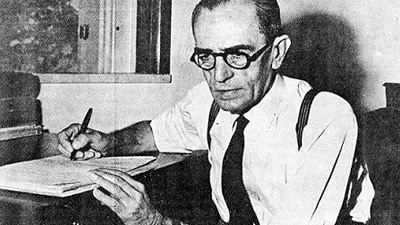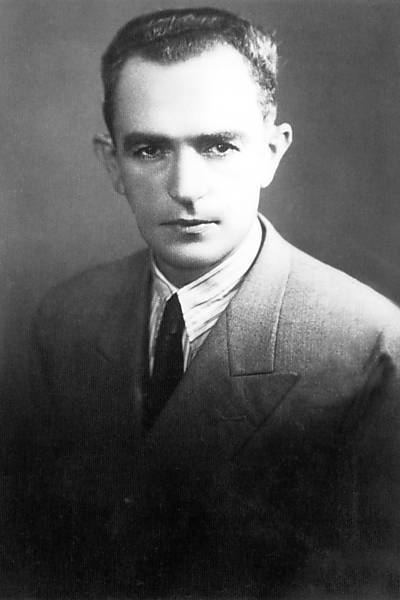Nationality Brazilian Role Writer Name Graciliano Ramos | Height 1.75 m (5 ft 9 in) Ethnicity White | |
 | ||
Full Name Graciliano Ramos de Oliveira Other names Feliciano de OlivencaAlmeida Cunha Notable work Vidas Secas, Angustia, Sao Bernardo, A Terra dos Meninos Pelados Movies Barren Lives, Sao Bernardo, Memories of Prison Spouse Heloisa Leite de Medeiros (m. 1928–1953), Maria Augusta de Barros (m. 1915–1920) Children Ricardo Ramos, Marcio Ramos, Luisa Ramos, Roberto Ramos, Maria Ramos, Clara Ramos, Mucio Ramos, Junio Ramos Books Vidas Secas, Infancia, Alexandre e outros heróis, Angustia, Memorias do carcere Similar People Jorge Amado, Jose Lins do Rego, Rachel de Queiroz, Machado de Assis, Joao Guimaraes Rosa | ||
Ramos
Graciliano Ramos de Oliveira ([gɾasili'ɐ̃nu 'ʁɐ̃mus dʒi oli'vejɾa]) (October 27, 1892 – March 20, 1953) was a Brazilian modernist writer, politician and journalist. In most of his novels (more prominently in Vidas Secas) he depicts the precarious situation of the poor inhabitants of the Brazilian sertão.
Contents
- Ramos
- Depoimento de antonio candido no simp sio graciliano ramos 75 anos do livro ang stia
- Life
- Religion
- Novels
- Childrens literature
- Short story books
- Memoirs
- Chronicles
- Translations
- Miscellaneous
- Film adaptations
- References

Depoimento de antonio candido no simp sio graciliano ramos 75 anos do livro ang stia
Life

Graciliano Ramos de Oliveira was born in the city of Quebrangulo, in the Brazilian state of Alagoas, on October 27, 1892, to Sebastião Ramos de Oliveira and Maria Amélia Ramos. Graciliano was the oldest of the couple's 16 children.

He would spend most part of his childhood travelling through different cities of Northeast Brazil. After finishing high school in Maceió, he became a collaborator of the newspaper Jornal de Alagoas in 1909, where he published a sonnet called "Céptico" under the pen name Almeida Cunha, and some other texts under many different pseudonyms. He also published texts in the magazine O Malho, under the pen name Feliciano de Olivença, and founded a short-lived periodical named Echo Viçosense in 1906.
In 1914 he moved to Rio de Janeiro, but had to return to Alagoas in September 1915, in order to live with his father, who became a salesman in the city of Palmeira dos Índios. Also in 1915, he married his first wife, Maria Augusta de Barros, having with her four children. Maria Augusta died in 1920, due to troubles during childbirth.
In 1927, Ramos was elected mayor of Palmeira dos Índios: he took office in 1928 and would abdicate his post in 1930. Mesmerized by the high literary quality of his prefecture reports, Augusto Frederico Schmidt would approach Ramos into publishing his first novel, Caetés, that Ramos started to write circa 1925. He would finish Caetés in 1930, but did not publish it until 1933. In 1928, he married his second wife, Heloísa Leite de Medeiros, having with her four more children.
From 1930 to 1936 he lived once again in Maceió. In 1934 he published the novel São Bernardo, and in the following year, he was arrested due to alleged (but never confirmed) participation in the Communist Revolt of 1935. (Graciliano wrote an account of his time in prison named Memórias do Cárcere, published a few months after his death in 1953.) After being freed from prison, he publishes with the help of associates such as José Lins do Rego his most famous novel, Angústia.
In 1938 he publishes Vidas Secas and moves definitely to Rio de Janeiro, where he became in 1945 a member of the Communist Party of Brazil. In the subsequent years, he travelled alongside his wife to countries such as France, Portugal, the Soviet Union and Czechoslovakia. Also in 1945 he published an account of his childhood years, named Infância.
Beginning in 1952, Graciliano's health gradually began to decline. He was diagnosed with lung cancer and, after an unsuccessful surgery, died on March 20, 1953. His wife Heloísa would die 46 years later, in Salvador, Bahia.
Graciliano is survived by one daughter and many grandchildren and great-grandchildren.
Religion
Graciliano described himself as an atheist, although he enjoyed reading the Bible.
Novels
Children's literature
Short story books
Memoirs
Chronicles
Translations
Miscellaneous
Film adaptations
Ramos had three of his works adapted to cinema:
